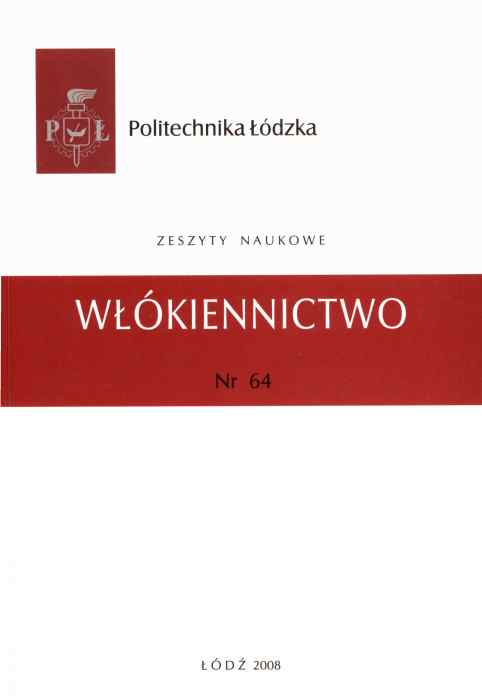Abstrakt
W technologiach włókienniczych występują strefy rozciągania nitek, pomiędzy elementami maszyn lub na ich elementach roboczych, przez które przędza przemieszcza się, podlegając rozciąganiu. Długość tych stref wynosi od kilku milimetrów do kilku metrów. Zmienność napięć w przemieszczanych nitkach spowodowana jest warunkami technologicznymi oraz czynnikami związanymi z niejednorodnością własności mechanicznych. Modelowanie matematyczne sil spotykane w literaturze zwykle nie uwzględnia niejednorodności mechanicznych surowca i dlatego daje wartość średnią siły, bez parametrów rozrzutu jej wartości, który obserwuje się w rzeczywistych procesach.
Autor podjął próbę oceny niejednorodności własności mechanicznych przędzy i określenia jej wpływu na generowanie i charakterystykę sil w nitkach przemieszczających się przez strefę rozciągania. Zbudował również prototypowy tester przędzy.
Bibliografia
Włodarczyk B., Kowalski K.: A Discrete Probability Model of Forces in Yarns Transported Through the Drawing Zone. FIBRES & TEXTILES in Eastern Europe April/Juni 2006, Vol. 14, No. 2 (56).
Włodarczyk B.: Ocena niejednorodności właściwości mechanicznych nitek na podstawie analizy sił w nitce w krótkiej strefie rozciągania. Praca doktorska, Wydział Inżynierii i Marketingu Tekstyliów, Politechnika Łódzka, Łódź 2007.
Knapton J.F., Mondeo D.L.: A Study of the Mechanism of Loop Fonnation on Weft- Knitting Machinery. Text. Res. J. 12 (1966), s. 1072-1091.
Knapton J.F.: The Dynamics of Weft-Knitting. Text. Res. J. 9 (1968) s. 914-924.
Aisaka N.: Mathematical Considerations of Weft-Knitting Process. J. Tex. Mach. Soc. Japan 3 (1971) s. 82-91.
Kowalski K.: Modelowanie procesu przeciągania nitek przez bariery cierne - model fizyczny procesu przeciągania nitek przez bariery cierne. Przegl. Włók. 41 (1987) 4, s. 163-166.
Kowalski K.: Analiza modelu reologicznego procesu przeciągania nitek przez bariery cierne. Przegl. Włók. 41 (1987) 6, s. 226-229, 14 rys. 22 poz. lit.
Kowalski K.: Modellierung der Faden-Festkorper-Reibung. Melliand Textilberichte 3/1991 s. 171-175, 14 rys., 22 poz. lit.
Kowalski K.: Identyfikacja dynamicznych sił w nitkach na szydełkarkach na podstawie symulacji komputerowej i cyfrowej techniki pomiarowej. Zeszyty Naukowe PŁ nr 613, Łódź 1991.
Bauer H.J.: Positive Fadenzufurung an Strickmaschinen - der Schliissel zur Gestrickqualitiit, Maschen-Industrie 46 ( 1996) 6, s. 4 75-4 79.
Wiinsch I., Pusche Th., OłTermann P.: Fadenzufahrung an Runstrickmaschinen und eine neue Art Prozessdarstellung. Melliand Textilberichte 5/1999 s. 388-392.
Żyliński T.: Nauka o włóknie. WPLiS Warszawa 1958.
Urbańczyk G.: Fizyka włókna. Własności.fizyczne włókien WNT, Warszawa 1974.
Ryk.lin D.B., Rineisky K.N., Kogan A.G.: Komputerowa symulacja procesu rozciągania. Materiały VI Międzynarodowej Konferencji Naukowej ,,IMTEX 2000", Łódź 5-6 czerwca 2000 roku.
Żurek W.: Struktura liniowych wyrobów włókienniczych. WNT, Warszawa 1989.
Bauer A., Winkler F.: Dynamische Zugprufung von Faden, IV Hystereischleife. Faserforsch und Textiltechnik 16, 1965, 4, s. 304-312-23.
Bauer A., Winkler F.: Dynamische Zugprufung von Faden, V Die Dampfung. Faserforsch und Textiltechnik 16, 1965, 8, s. 382-387-24.
Bauer A., Winkler F.: Dynamische Zugprufung von Faden, VI Phasenwinkel und Verlustwinkel. Faserforsch und Textiltechnik 26, 1965, 9, s. 456-463.
Nitzche K., Bauer A., Winkler F.: Relaxationsuntersuchugen an polymeren Festkorpem unter Aspekt der eksperimentellen Systemanalyse. Forschung und Textiltechnik 26, 1075, 11, s. 527-532.
Szosland J., Czołczyński M.: Prędkość rozchodzenia się impulsu napięciowego w nitkach. Przegląd Włókienniczy 27, 1973, 11, s. 527-532.
OłTermann P., Schafer J., Schubert E.: Zur Teorie und Praxis bei der Fadenverarbeitung insbesondere in der Strickerei. Beilage 2/1979 zu den ,Jnformation Trikotagen und Strumpfe", VEB Wissenschaftlich - Technische Zentrum Trikotagen und Strumpfe, Limbach-Oberfrohna. - 28.
Lewiński J.: Dynamiczne napięcia nitek podczas snucia. Praca doktorska. Politechnika Łódzka, Łódź 1975.
..., T. 29, 6 (1969), C. 42-45.
Więźlak W., Nowak R.: Mierzenie statycznego i dynamicznego napięcia w nici szwalniczej w procesie szycia. Zeszyty Naukowe Politechniki Łódzkiej, Włókiennictwo z. 16, ( 1967).
Fieles-Kahl N., Helli I.G.: Zusamenhange zwieschen Luftfeuchte, Temperatur und den Reibungskoeffizienten von Gamen. Textil Praxis 21, 5 i 6 ( 1966).
... 1 (1963), c. 158-161.
Bland D.R.: The Theory of linear Viscoelasticity. Pergamon Press 1960.
Włodarczyk B., Kowalski K.: Discrete Probalistic Model of Forces in a Thread with Visco-elastic Properties transported Through a Drawing Zone, Fibres & Textiles in Eastern Europe 2007.

